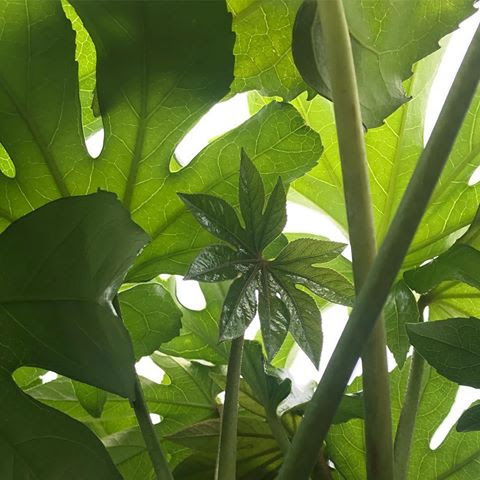
Fatsia japonica
Listen to the Fatsia Japonica Podcast here!
Contents
- Top Tips
- Location, Water, Humidity & Fertilisation
- Common Issues
- Origins, Temperature, Propagation, Repotting & Toxicity.
Need the answer to a specific plant query? Book a 1-to-1 video call with THE HOUSEPLANT DOCTOR™, the website's friendly author, to overcome and address your niggling problem! Available on iMessage, WhatsApp, Facebook Messenger & more.
Top Tips & Info
- Care Difficulty - Moderate
- Provide a bright location with a few hours of morning or evening sun, avoiding dark sites if possible.
- Water once the soil's top third dries out, reducing this slightly further in the autumn and winter.
- Fertilise using a 'Houseplant' labelled feed every four waters in the spring and summer, reducing this to every six in the colder months.
- Regularly check for Mealybugs and Spider Mites that'll locate themselves in the foliage's cubbyholes.
- Repot every two years using a 'Houseplant' potting mix and the next sized pot.
- Important Note: Fatsia japonica is a species that prefers a dormant period between the months of mid autumn to early spring. During this period, provide a location that offers a few hours of potential sunlight per day, while keeping its soil on the dry side during this period to avoid over-watering.
Location & Light - 🔸🔸🔸
A whole host of different light levels can be tolerated; however, overexposure to the sunlight should not occur. Spindly growth is the result of too little light, whereas pale, washed-out leaves are the opposite. A Fatsia kept in a bright position must be monitored for dry soil as browning leaves, or deformed juvenile growth are crucial signs of too much sunlight.
In terms of the ideal location, a few metres within a window, or with overhead lighting is best. You must avoid situations where a newspaper can't be read due to the heightened chance of over-watering and root rot.
Water - 🔸🔸🔸
During the growing period, allow the soil's top third to dry out in between waters, reducing this slightly more in the autumn and winter. If your Fatsia receives some sunlight throughout the day, be sure to keep on top of soil moisture as the combination of dehydration and sun-scorch will result in brown distorted growth. Under-watering symptoms include the leaf edges turning brown, distorted growth and pale or spotty foliage; these issues are commonly due to one of three main reasons; too much sunlight, a much needed repot or forgetfulness. Over-watering symptoms include yellowing or browning stem, yellowing lower leaves and wilting. Never let your Fatsia sit in standing water, and alternatively don't water until around a third of the soil dries out - especially those in darker locations.
Humidity - 🔸
Create a humidity tray to provide a moist and stable environment for your plant. If the surrounding saturation is too low or the heat too high, its foliage may start to brown over and curl, especially in direct sunlight. Hose the foliage down from time to time to hydrate the leaves and keep the dust levels down.
Fertilisation - 🔸🔸
Fertilise every four waters during the growing period before reducing this to every six in the autumn & winter. Although an 'All-Purpose' fertiliser will still do the job, we'd recommend using a specific 'Houseplant' labelled fertiliser as it'll support the vital thirteen nutrients that this species will need to grow.
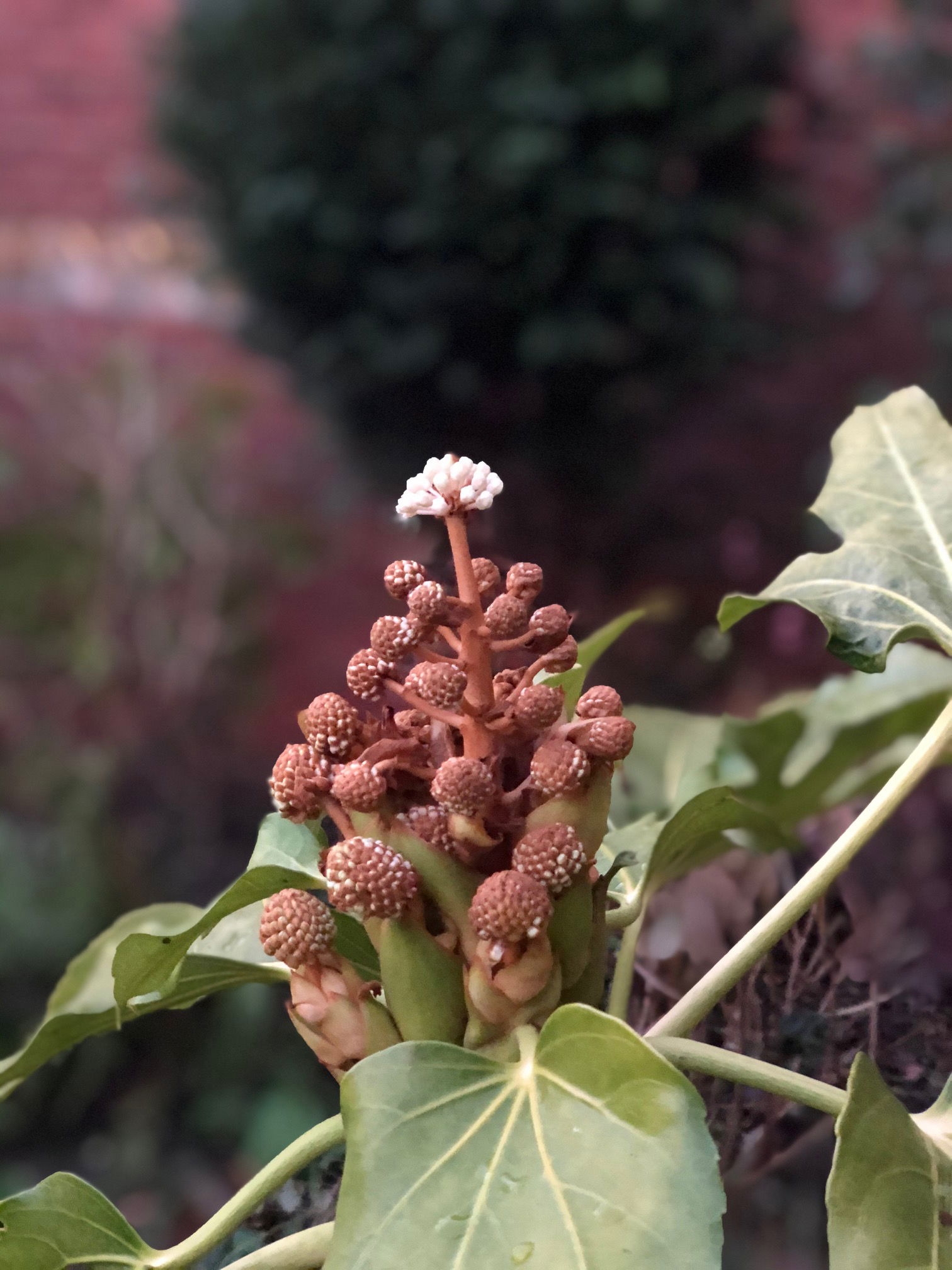 The fluorescences of an F. japonica.
The fluorescences of an F. japonica.
Common Issues with Fatsia Japonica
Inconsistent watering which involves droughts and prolonged water-logging will not be accepted by a Fatsia, resulting in root rot, foliage decline and stunted growth. For those that are grown in brightly lit spots, only allow a third of the soil to dry out in between waterings, with darker locations allowing over half. If you're a forgetful gardener, set up a watering-rota so that it prompts you to re-hydrate efficiently.
Root rot is a common issue among specimens sat in too dark environments with prolonged soil moisture. Symptoms include rapidly yellowing leaves, mouldy soil, stunted growth and a rotten brown base. Take the plant out of the pot and inspect health below the soil line. If the roots sport a yellow tinge, you're good to go, but if they're brown and mushy, action must be taken immediately. More information about addressing root rot can be found on this link.
Lower leaf loss is a common and significant issue among gardeners. This unfortunate phenomenon could be a product of several different problems, most notably being dark locations, water-related abuse or environmental shock. Introduce the plant to a more well-lit area with a splash of off-peak sunlight; if caught in time, the leaf loss should stop within a week. If you feel that you're watering habits aren't up to scratch, familiarise yourself with our care tips provided at the top of this article. It's always best to under-water this species than over-do it, purely on its poor ability to endure continued sogginess. The final culprit could be down to a sudden relocation; if you've recently purchased the specimen, the chances are it is still acclimatising to the new environment. Although this shouldn't happen, a vastly different setting will cause sudden foliage loss and stunted growth. You'll have two options of either waiting it out or presenting a more Fatsia-friendly environment, mentioned in the 'Location & Light' section.
If your specimen is located in a dark environment with mould developing on the soil's surface, use a chopstick to stab the soil in various areas gently. You should aim to enter the compost between the base of the plant and the pot's edge, as failure to do so may lead to damaging its lower portion. Leave the holes open for a few days before re-surfacing the soil to avoid it becoming overly dry. Not only will the gentle shift in the soil's structure mimic the work of small invertebrates in the wild (worms, etc.), but it'll also add oxygen back into the soil, thus reducing the risk of root rot. Repeat this monthly, or whenever you feel the potting-mix isn't drying out quickly enough.
Leggy or spindly leaves/stems are the result of low light. Increase your plant's light levels by relocating it to within 2m (6ft) of a window that offers up to two hours of early morning (before 9am) or evening sunlight (after 7pm). Don't prune the already-leggy foliage and instead wait for more compact growth that may take up to two months to grow. Feed regularly and maintain reliable soil moisture.
Environmental Shock is a familiar occurrence with newly-located specimens, that usually results in stunted growth and lower leaf loss (rare). When a plant is relocated into a new, unfamiliar setting, the effects can be catastrophic. The humidity, temperature and light levels will all suddenly shift into different proportions, inflicting great stress the individual. There are two options of addressing this issue; either wait it out or relocate it into a more Fatsia-friendly environment. As long as the specimen appears healthy with little change to its pre-existing leaves, new nodular growth should emerge in the following months.
Too low humidity can cause browning tips with yellow halos on juvenile leaves. Although this won't kill your specimen, you may want to increase the local moisture to prevent the new growth from adopting these symptoms. Mist or rinse the foliage from time to time and create a humidity tray while the heaters are active to create a stable environment. The browning of leaf-tips on older leaves is wholly natural and is the product of extensive photosynthesis during its life.
Brown crispy new-growth that's become deformed is the product of over-exposure to the sun and dehydration. As mentioned previously, Fatsia will grow best in bright, indirect light with regular waters. Remove the affected leaf and improve the growing conditions to counteract this issue occurring again. In some cases, Spider Mites could be the culprit for the abnormality, with small, near-transparent critters slowly extracting the chlorophyll out of the leaves. Have a check under the rest of the foliage, most notably along the midrib, for small webs and gritty yellow bumps. Click here to read our article about the eradicating Spider Mites, along with some extra tips that you may not find elsewhere!
Origins
The species was first described under the name of 'Aralia japonica' by Carl Peter Thunberg in 1780, before being reclassified by Planchon in 1854. The kept the species name, 'Japonica', as a nod to Thunberg's previous works, but replaced it in the newly-constructed Fatsia genus. The latter can be translated from the Japanese word for 'eight', which refers to the number of lobes on a matured leaf.
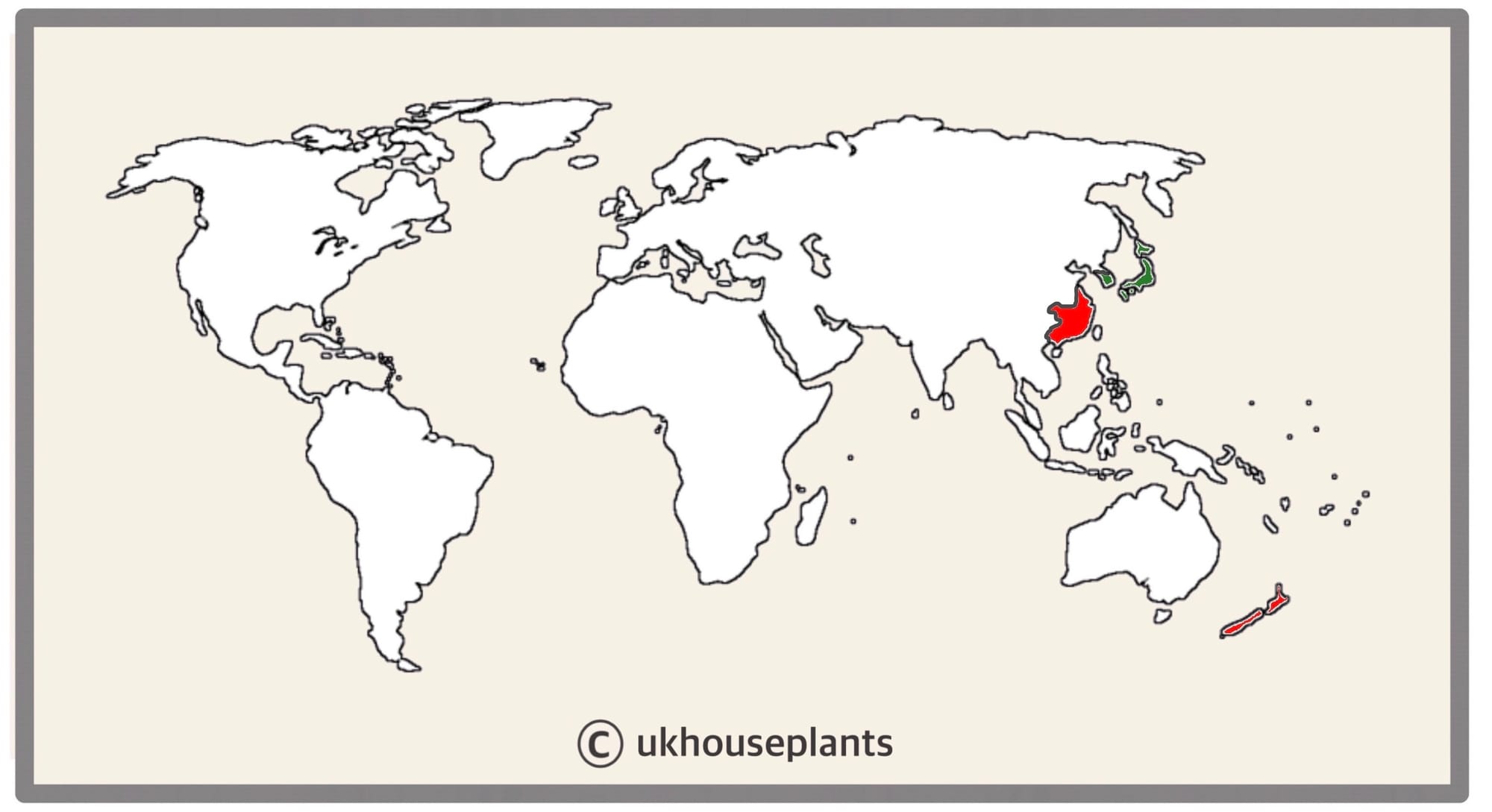 The Distribution of Fatsia japonica in Green & artificial introduction in Red.
The Distribution of Fatsia japonica in Green & artificial introduction in Red.
Temperature
-5° - 30°C (23° - 86°F)
H5 - Tolerant of temperatures below freezing, although they're best grown above 10°C.
Spread
Up to 2m in height and over 1m in width. The ultimate height will take between 5 - 10 years to achieve indoors, with several new leaves put-out each season.
Pruning & Maintenance
Remove yellow or dying leaves, and plant debris to encourage better-growing conditions. While pruning, always use clean scissors or shears to reduce the chance of bacterial and fungal diseases. Never cut through yellowed tissue as this may cause further damage in the likes of diseases or bacterial infections. Remember to make clean incisions as too-damaged wounds may shock the plant, causing weakened growth and a decline in health.
Propagation
Via Seed or Stem Cuttings.
Stem & Eye Cuttings (Moderate) - This method of propagation is troublesome without the aid of bottom-heat and a controlled environment. Choose the healthiest, most established stems that are wooded, yet still juvenile enough to bend slightly. Each cutting should only have ONE leaf, and a small portion of the stem to either side of the node. Cut directly below a node using a clean knife to reduce bacteria count. Situate the cutting into moist 'Houseplant' compost, with the only the leaf sticking out of the soil. Blackleg can occur when the bottom wound becomes infected, resulting in propagation failure - typically caused by water-logging or a too-damaged wound. Maintain bright light and evenly moist soil with the avoidance of direct sunlight or cold draughts. Wrap the pot (& foliage) in a transparent bag or within a miniature greenhouse, and provide bottom heat of temperatures above 18°C (54°F). Remove the bag and place into individual 7cm pots once the second new leaf emerges. Follow the same care routines, as mentioned in the article's top half. This method will take up to five months, so patience and the correct environment are paramount for success! Roots should develop within the first month of propagation, pushing out at the bottom of the pot - have a look at the images below to get a grasp of what's been written.
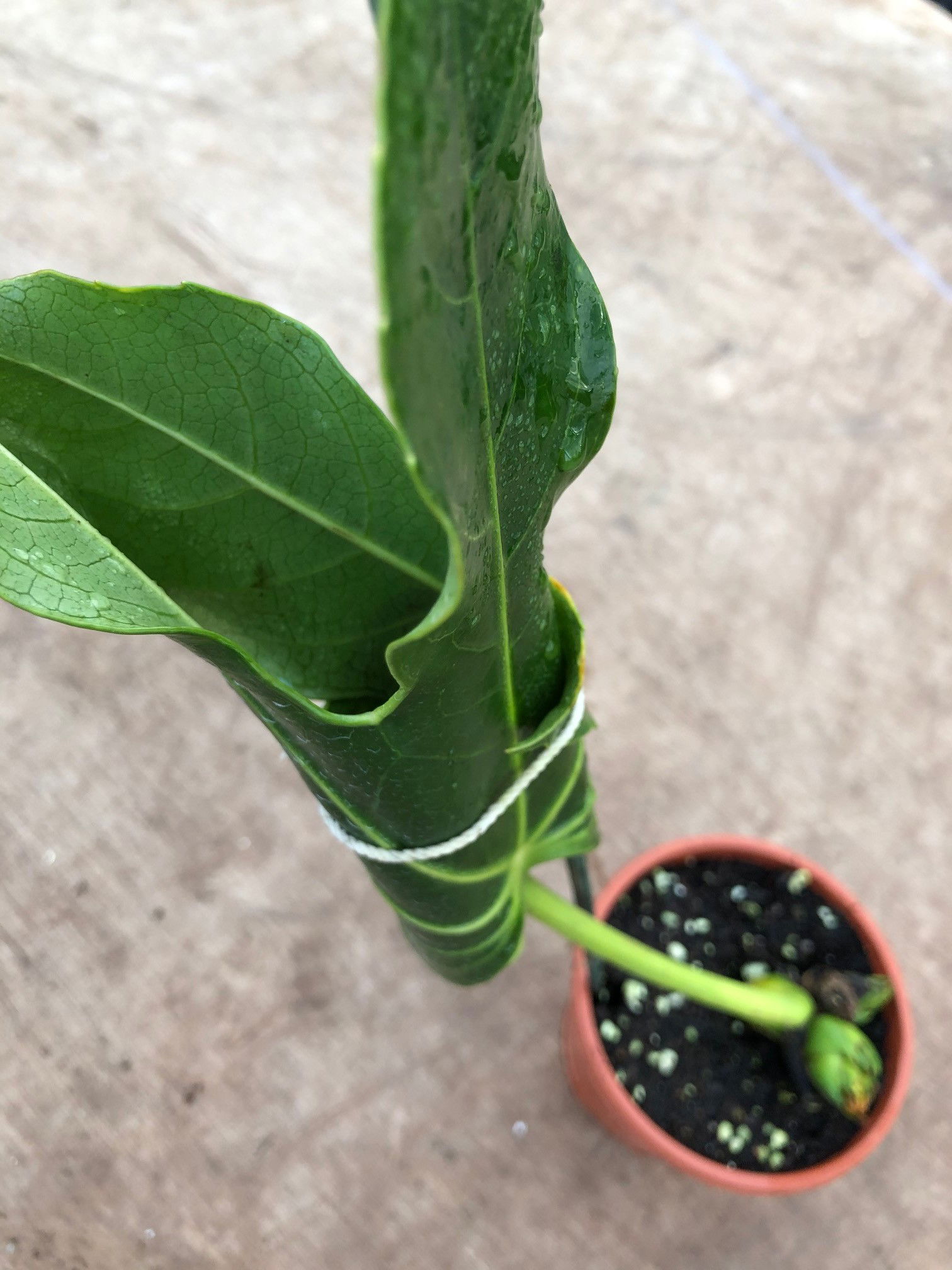 Wrap the leaf outwards around a small stick for the prevention of water-loss - this is a crucial element for its success.
Wrap the leaf outwards around a small stick for the prevention of water-loss - this is a crucial element for its success.
 The leading growth's terminals are among the best candidates for stem cuttings.
The leading growth's terminals are among the best candidates for stem cuttings.
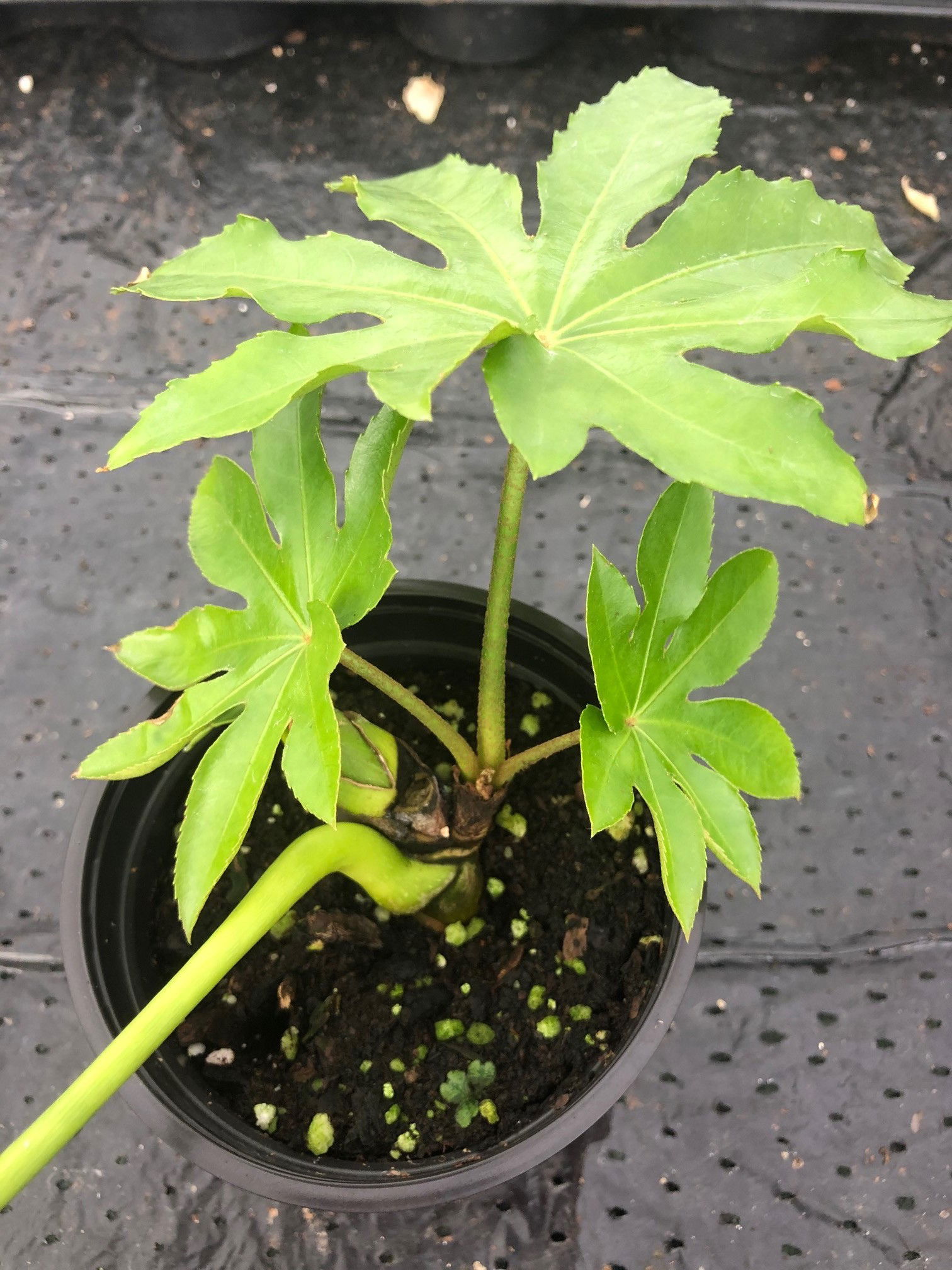 The same specimen three months later...
The same specimen three months later...
Flowers
Fatsia will produce small clusters of globular white flowers during spring or summer; however, it's extremely rare to bloom indoors and therefore is otherwise grown for it's tropical attire. Have a look at the second image above to see the development of its flowers.
Repotting
Repot every two years in the spring using a Houseplant' labelled compost and the next sized pot with adequate drainage. Hydrate the plant 24hrs before tinkering with the roots to prevent the risk of transplant shock. For those that are situated in a darker location, add a thin layer of small grit in the pot's base to improve drainage and downplay over-watering. Click here for a detailed step-by-step guide on transplantation, or via this link to learn about repotting with root rot.
Book a 1-to-1 video call with THE HOUSEPLANT DOCTOR™ if you'd like a personal guide to repotting your houseplant. This will include recommending the right branded-compost and pot size, followed by a live video call whilst you transplant the specimen for step-by-step guidance and answer any further questions!
Pests & Diseases
Keep an eye out for mealybugs, spider mites, scale, thrips & whitefly that'll locate themselves in the cubbyholes and undersides of the leaves. Common diseases are root rot, leaf-spot disease, botrytis, powdery mildew & southern blight - click here to learn more about these issues.
Toxicity
This plant is classified as poisonous. If parts of the plants are eaten, vomiting, nausea and a loss of appetite could occur. Consumption of large quantities must be dealt with quickly - acquire medical assistance for further information.
Retail Locations
Blue Diamond, British Garden Centres, Dobbies, Online Stores. Most Fatsia japonica are usually sold outside during summer at most garden centres; you can bring them indoors as long as they're checked for pests and diseases beforehand.
Book a 1-to-1 Call with THE HOUSEPLANT DOCTOR™
If you need further advice with your houseplants, book an advice call with ukhouseplants' friendly and expert writer today! This can be done via a video or audio call on most apps, including Facebook, FaceTime & Skype. A ten-minute call costs £5.99 (US$7), or £15.99 for thirty minutes. You can ask multiple questions, including queries on plants, pests, terrariums, repotting advice and anything in between. Please consider supporting this service to keep ukhouseplants thriving!